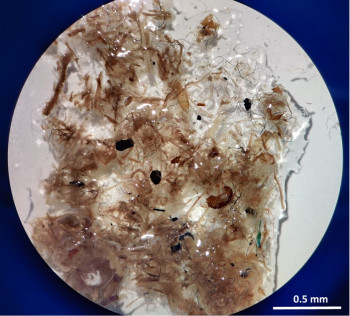Confirmed: If sewage sludge is applied to fields, microplastics can …

The sample from a soil treated with sewage sludge shows microplastic fibres of 0.5 millimetres or more among plant fibres. (Photo: IOW / A. Tagg)
… get into deeper soil layers and onto adjacent areas.
The fact that sewage sludge from municipal waste water treatment plants contains a high proportion of microplastics has already been shown in earlier studies. It was suspected that the use of such sludge for fertilising fields could also promote the uncontrolled input of microplastics into the wider environment. Now, studies conducted as part of the project MicroCatch_Balt funded by the German Federal Ministry of Education and Research confirm this assumption.
Microplastics are plastic particles that are smaller than 5 mm. Scientists find them all over the world, even in such remote places as the Arctic and Antarctic. In spite of this omnipresence, knowledge about the sources of this pollution is scarce. But knowledge of the sources is a crucial prerequisite for the taking of effective action against the input of MP into the environment. In recent years, comprehensive research efforts have therefore been made all over the world to close such knowledge gaps.
Sewage sludge has been targeted as a possible source for some time. They often contain large amounts of microplastics and are used as fertiliser in agriculture in some countries. Environmental researchers from the Leibniz Institute for Baltic Sea Research Warnemünde (IOW), the Johann Heinrich von Thünen Institute, Federal Research Institute for Rural Areas, Forestry and Fisheries in Braunschweig and the Leibniz Institute of Polymer Research Dresden investigated the MP contamination in the surface ploughing horizon and in the deeper soil below at a test field that had been regularly fertilised with sewage sludge since the 1980s at the Agricultural Investigation and Research Station in Speyer, Germany. They also investigated MP presence in a nearby control field, never treated with sludge. The team of authors led by Alexander Tagg (IOW) now presented their results in the international journal Science of the Total Environment.
“As expected, we found relatively many microplastic particles on the sludge-treated test field. But on the nearby untreated field we also found MPs. The amount corresponded to 44 % of what we found in the surface area of the test field,” reports Alexander Tagg. This finding alone would not have been enough to prove a connection. “However, the polymer-type composition of the microplastic particles shows an almost identical spectrum at both locations. In our opinion, this can only be explained by a transport from the test field.”
In addition, microplastics were detected in the sewage sludge-treated soil of the test field at a depth of 60-90 cm, suggesting that it can also penetrate deep enough to reach agricultural drainage systems. However, the amount of MP detected at depth was very low (1.6 % of the surface load) and the controlled long-term and intensive sewage sludge treatment of the investigated test field was far above what is allowed in agriculture under the Sewage Sludge Directive.
“It is not the current levels of the microplastic load that concern us, but the fact that these plastics get into the environment, where they are persistent. They will not disappear and will continue to accumulate if we do not close the sources,” Matthias Labrenz, leader of the project MicroCatch_Balt (Investigation of microplastic sinks and sources from a typical catchment area to the open Baltic Sea) funded by the German Federal Ministry of Education and Research comments on the findings. And he concludes: “The spreading of municipal sewage sludge on agricultural land can lead to further uncontrolled contamination.” However, sewage sludge is just one source from which MP can escape into the environment. To assess its importance in relation to other sources, e.g., tire wear and atmospheric dust deposition l, further research is urgently needed.
Wissenschaftliche Ansprechpartner:
Dr. Alexander Tagg | phone: +49 381 5197 315 | alexander.tagg@io-warnemuende.de | Department Biological Oceanography, Leibniz Institute for Baltic Sea Research
Prof. Dr. Matthias Labrenz | phone: +49 381 5197 378 | matthias.labrenz@io-warnemuende.de, Department Biological Oceanography, Leibniz Institute for Baltic Sea Research
Originalpublikation:
Tagg, A. S., E. Brandes, F. Fischer, D. Fischer, J. Brandt and M. Labrenz (2022). Agricultural application of microplastic-rich sewage sludge leads to further uncontrolled contamination. Sci. Total Environ.: 150611, doi: https://doi.org/10.1016/j.scitotenv.2021.150611
Media Contact
All latest news from the category: Ecology, The Environment and Conservation
This complex theme deals primarily with interactions between organisms and the environmental factors that impact them, but to a greater extent between individual inanimate environmental factors.
innovations-report offers informative reports and articles on topics such as climate protection, landscape conservation, ecological systems, wildlife and nature parks and ecosystem efficiency and balance.
Newest articles

Innovative 3D printed scaffolds offer new hope for bone healing
Researchers at the Institute for Bioengineering of Catalonia have developed novel 3D printed PLA-CaP scaffolds that promote blood vessel formation, ensuring better healing and regeneration of bone tissue. Bone is…

The surprising role of gut infection in Alzheimer’s disease
ASU- and Banner Alzheimer’s Institute-led study implicates link between a common virus and the disease, which travels from the gut to the brain and may be a target for antiviral…

Molecular gardening: New enzymes discovered for protein modification pruning
How deubiquitinases USP53 and USP54 cleave long polyubiquitin chains and how the former is linked to liver disease in children. Deubiquitinases (DUBs) are enzymes used by cells to trim protein…



